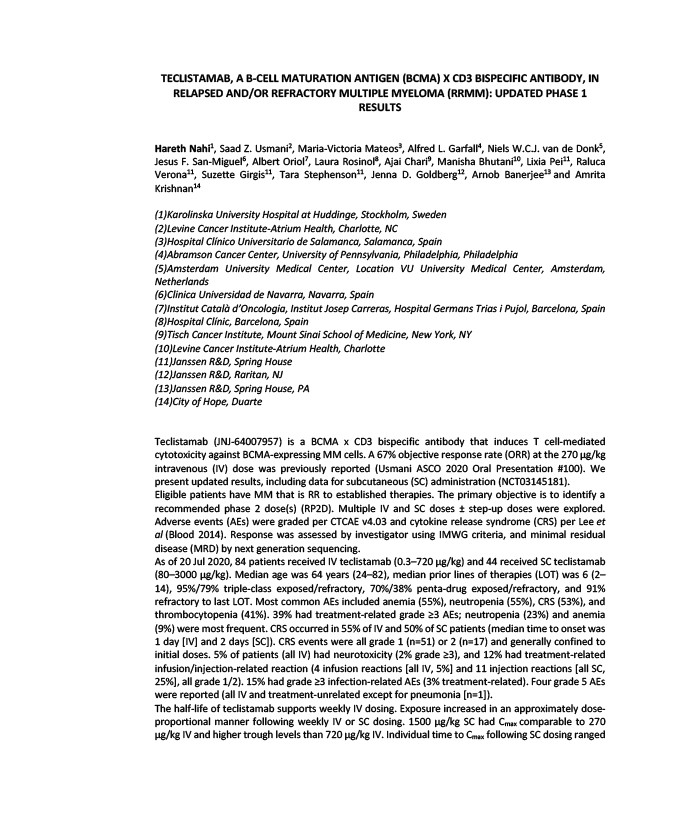
TECLISTAMAB, A B-CELL MATURATION ANTIGEN (BCMA) X CD3 BISPECIFIC ANTIBODY, IN
RELAPSED AND/OR REFRACTORY MULTIPLE MYELOMA (RRMM): UPDATED PHASE 1
RESULTS
Hareth Nahi1, Saad Z. Usmani2, Maria-Victoria Mateos3, Alfred L. Garfall4, Niels W.C.J. van de Donk5,
Jesus F. San-Miguel6, Albert Oriol7, Laura Rosinol8, Ajai Chari9, Manisha Bhutani10, Lixia Pei11, Raluca
Verona11, Suzette Girgis11, Tara Stephenson11, Jenna D. Goldberg12, Arnob Banerjee13 and Amrita
Krishnan14
(1)Karolinska University Hospital at Huddinge, Stockholm, Sweden
(2)Levine Cancer Institute-Atrium Health, Charlotte, NC
(3)Hospital Clínico Universitario de Salamanca, Salamanca, Spain
(4)Abramson Cancer Center, University of Pennsylvania, Philadelphia, Philadelphia
(5)Amsterdam University Medical Center, Location VU University Medical Center, Amsterdam,
Netherlands
(6)Clinica Universidad de Navarra, Navarra, Spain
(7)Institut Català d’Oncologia, Institut Josep Carreras, Hospital Germans Trias i Pujol, Barcelona, Spain
(8)Hospital Clínic, Barcelona, Spain
(9)Tisch Cancer Institute, Mount Sinai School of Medicine, New York, NY
(10)Levine Cancer Institute-Atrium Health, Charlotte
(11)Janssen R&D, Spring House
(12)Janssen R&D, Raritan, NJ
(13)Janssen R&D, Spring House, PA
(14)City of Hope, Duarte
Teclistamab (JNJ-64007957) is a BCMA x CD3 bispecific antibody that induces T cell-mediated
cytotoxicity against BCMA-expressing MM cells. A 67% objective response rate (ORR) at the 270 μg/kg
intravenous (IV) dose was previously reported (Usmani ASCO 2020 Oral Presentation #100). We
present updated results, including data for subcutaneous (SC) administration (NCT03145181).
Eligible patients have MM that is RR to established therapies. The primary objective is to identify a
recommended phase 2 dose(s) (RP2D). Multiple IV and SC doses ± step-up doses were explored.
Adverse events (AEs) were graded per CTCAE v4.03 and cytokine release syndrome (CRS) per Lee et
al (Blood 2014). Response was assessed by investigator using IMWG criteria, and minimal residual
disease (MRD) by next generation sequencing.
As of 20 Jul 2020, 84 patients received IV teclistamab (0.3–720 μg/kg) and 44 received SC teclistamab
(80–3000 μg/kg). Median age was 64 years (24–82), median prior lines of therapies (LOT) was 6 (2–
14), 95%/79% triple-class exposed/refractory, 70%/38% penta-drug exposed/refractory, and 91%
refractory to last LOT. Most common AEs included anemia (55%), neutropenia (55%), CRS (53%), and
thrombocytopenia (41%). 39% had treatment-related grade ≥3 AEs; neutropenia (23%) and anemia
(9%) were most frequent. CRS occurred in 55% of IV and 50% of SC patients (median time to onset was
1 day IV and 2 days SC). CRS events were all grade 1 (n=51) or 2 (n=17) and generally confined to
initial doses. 5% of patients (all IV) had neurotoxicity (2% grade ≥3), and 12% had treatment-related
infusion/injection-related reaction (4 infusion reactions all IV, 5% and 11 injection reactions all SC,
25%, all grade 1/2). 15% had grade ≥3 infection-related AEs (3% treatment-related). Four grade 5 AEs
were reported (all IV and treatment-unrelated except for pneumonia n=1).
The half-life of teclistamab supports weekly IV dosing. Exposure increased in an approximately dose-proportional
manner following weekly IV or SC dosing. 1500 μg/kg SC had Cmax comparable to 270
μg/kg IV and higher trough levels than 720 μg/kg IV. Individual time to Cmax following SC dosing ranged